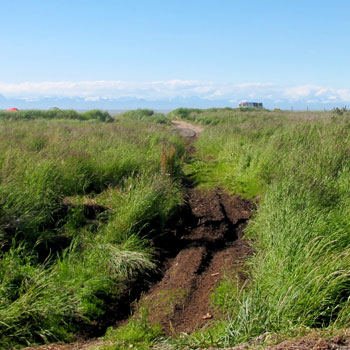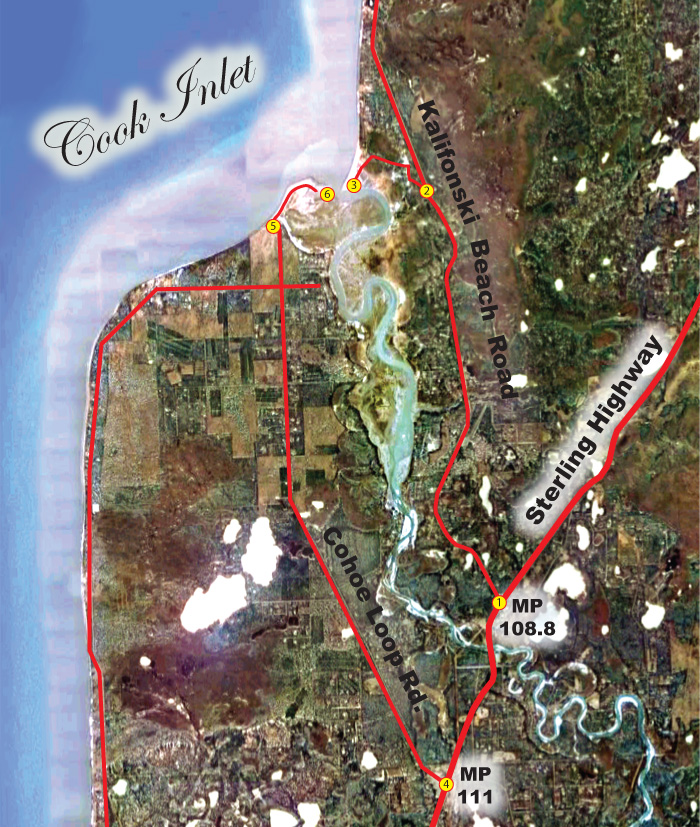Dipnetting the Kasilof River
The combination of rustic facilities and generally smaller fish than the neighboring Kenai River have resulted in a dipnet fishery that appeals to Alaskans who prefer to do things their own way; to be self-contained and free of the large crowds found on the beaches of the lower Kenai. This is the place to relax in your beach camp, build a campfire and to let the kids enjoy themselves. The Kasilof will likely always remain a comparatively quiet fishery, and that's just the way most Alaskans like it.
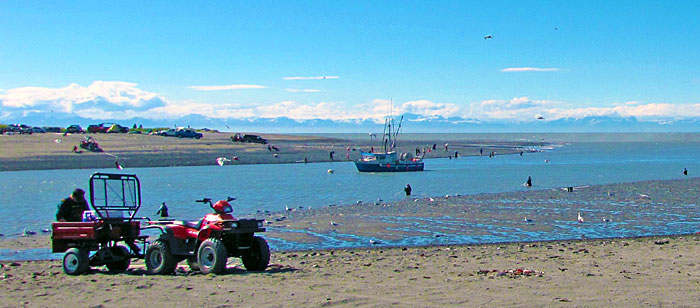
Available Species
The Kasilof River offers sockeye salmon for dipnetters. Although king salmon are found in the Kasilof, they are off-limits to dipnetters. The beach areas both north and south of the river mouth are open to personal-use gillnetting, where both sockeye and king salmon may be retained.
Timing
Reds begin moving into the Kasilof in early June, however the dipnetting and gilnetting season does not open until mid to late June, depending on whether you are dipnetting or gillnetting. The red run remains fishable through the end of the dipnetting season in early August.
Let's Go Dipnetting!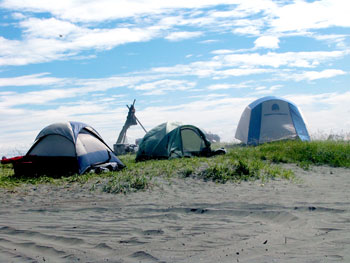
The Kasilof is a diverse fishery, offering both dipnetting and gillnetting opportunities. Though the gillnet fishery is outside the scope of this section, it should be noted that personal use gillnetters have a shorter season than the dipnetters, different fishing areas, and they are allowed to retain king salmon.
Legal Considerations
As is the case with salmon dipnetting anywhere in Alaska, you need to take care of the following legal minimums:
- Only Alaska residents are allowed to participate in dipnetting! Your nonresident friends and relatives are not allowed to handle any of the gear, the fish, or anything related to dipnetting. No, they can't even clean your fish for you.
- You must have your valid Alaska fishing license and dipnetting card with you the entire time you are dipnetting.
- Fish must be marked on your dipnetting card before they are removed from the fishing area. This includes fish that are in the cooler sitting behind your tent.
- Any fish that is placed in a cooler, bag or otherwise removed from public view must have the tips of the caudal fin (the tail) clipped at a 45-degree angle, to distinguish it from sport-caught fish.
- Keep careful count of your fish to avoid exceeding the bag limit.
- King salmon must be released immediately. You must know how to identify a king salmon!
Trespass Issues
The Kasilof River mouth area has some private property, and trespass is a concern for dipnetters. Almost the entire area north of the Kasilof Beach Road is private. Do not camp or ride ATVs in this area! There is also a small parcel of private land near a dock on the north side of the river, near the dipnetting area, where trespass is not allowed.
Dipnetters should also be aware that the river mouth is contained within the Kasilof River Special Use Area, which contains specific directions relating to trespass, habitat protection, ATV use, and camping. Refer to the State of Alaska Department of Natural Resources page on this for more details before heading to the Kasilof River to dipnet.
Conservation Concerns
The dunes at the Kasilof River mouth are part of a fragile ecosystem, easily destroyed by foot traffic and vehicle traffic. The grasses and sedges that grow along the beach area are vital to the beach ecosystem, because they provide shelter for wildlife, and their root systems stabilize the dunes so the sand does not blow away. Seemingly minor damage done by a single ATV crossing these areas is multiplied many times over by constant ATV traffic during the season. For the most part, dipnetters on the Kasilof seem to remain near the river mouth, but the long beaches invite ATV rides that could damage critical habitat. Stay off the dunes!
Portable toilets are provided in the area; please use them!
Safety Considerations
At low tide, soft, sticky mud is found near the river's edge, making it very easy to slip and end up in the river, or to become trapped in the mud. Avoid walking in areas where you can see watery mud, and never dipnet in these areas alone. Always wear a Personal Flotation Device whenever you are dipnetting, and if you are wearing chest waders, wear a wading belt over them. This will prevent the waders from completely filling up with water if you should fall in.
The river mouth sees a lot of commercial boat activity during dipnetting season, and these boats can throw up a very large wake. If you have waded out to the point where the water is only a few inches from the top of your waders, you're going to get soaked when a boat comes by. Back off a bit! Sockeye salmon are frequently caught in the shallow water behind the line of dipnetters! You will feel fish bumping your net pole and your legs if you're out too deep anyway. Pay attention to any boat traffic moving up or down the river, and back up before the wake hits you.
Health Concerns
Though the Kasilof River doesn't present nearly the volume of fish waste and bacterial counts seen on the more popular Kenai River, dipnetters should still take precautions. Seasonal elevated levels of fecal coliform and enterococci bacteria are found in the river. The bacterial overload is thought to be a result of large amounts of shorebirds (mostly gulls) that congregate in the lower river to consume fish waste discarded by dipnetters. Humans are exposed to the bacteria through ingesting contaminated river water. While most folks know better than to drink directly from the river, they will often clean their fish in river water, rinsing raw fillets in the river, thereby contaminating the flesh. These bacteria can cause stomach ache, diarrhea and other symptoms. 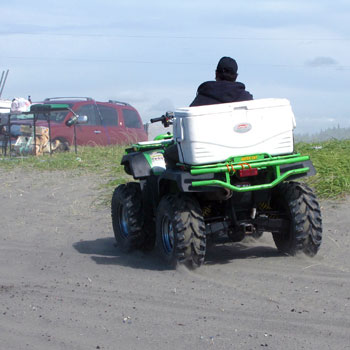
Dealing with potential bacterial contamination is a war that can be fought on two fronts. First, discard fish waste by chopping it up into small pieces and tossing it into the main channel, where it can be carried out to sea. Second, avoid rinsing your fillets directly in the river. Instead, rinse them off at home with clean water.
Be sure to pick up all your trash, including food scraps. Never deposit human waste in the beach areas; use the Porta-Potties that are stationed strategically in the river mouth area.
Access to the Kasilof River
There are three ways commonly used to access the lower Kasilof River, and your choice will depend on whether you intend to dipnet from the north bank or the south bank. The scenic route to the north bank starts near the lower Kenai River, on Kalifonski Beach Road (known locally as "K-Beach Road". The road follows the shoreline of Cook Inlet, running along bluffs positioned high above the beach areas. If you have time, this is a nice drive, with plenty of overlooks from which you can watch beach-based or boat-based setnetters during the peak of the season. Bring a binocular or spotting scope. During the peak of the run, there will be lots of activity in this area. Take K-Beach Road south to Kasilof Beach Road. Turn right, toward the beach, and then turn left at the "Y", to access the north beach area.
The other way to access the north beach area is to take the Sterling Highway south from Soldotna, and turn right at MP 108.8, onto K-Beach Road. Continue to Kasilof Beach Road, and turn left. Continue to the "Y", where you'll take another left to access the beach area.
Access the south beach dipnetting area by taking the Sterling Highway south from Soldotna. Turn Right at MP 111, and drive west on Cohoe Loop Road. Where Cohoe Loop Road turns left, continue straight onto Cohoe Beach Access Road to the beach. Drive right along the beach until you come to the dipnetting area. 4WD is necessary to drive on the beach without getting stuck.
1. K-Beach Road Turnoff
2. Kasilof Beach Road Turnoff
3. North Beach Dipnetting Area
4. Cohoe Loop Road Turnoff
5. Cohoe Beach Access Road
6. South Beach Dipnetting Area
Dipnetting Details on the lower Kasilof River
There are several things to be aware of when you're planning a dipnetting trip to the lower Kasilof. First, the fish are considerably smaller than the nearby Kenai River. For many dipnetters, this is a deal-breaker. For others who are willing to trade smaller fish for a more relaxing, laid-back experience, the Kasilof could be just the ticket. That said, there are some details you need to know. The Kasilof, just like the lower Kenai River, is a critical habitat area that cannot handle a lot of negative human interaction. That means that your ATV needs to remain on designated trails, or in beach areas where riding is allowed. This map shows some of the things you need to know about the lower Kasilof dipnetting area.
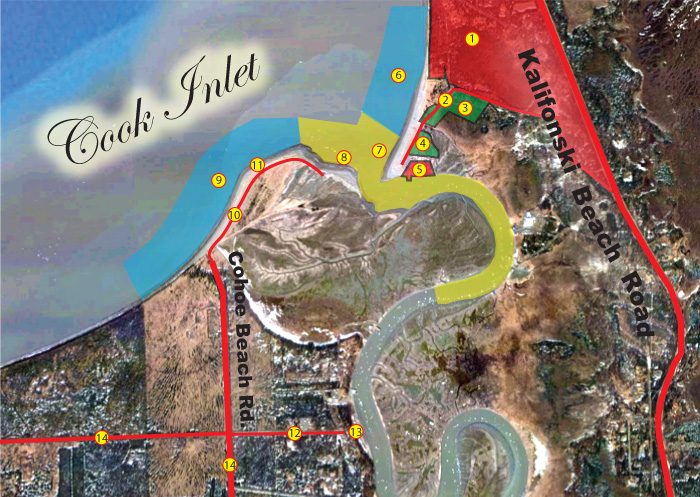
1. Private Property. The uplands north of Kasilof Beach Access Road, and inland from the beach to the west are private property, where trespass is not allowed. Do not camp in this area!
2. Kasilof Beach Access Road. Turn off of K-Beach Road onto the Kasilof Beach Access Road. When you get to the "Y", turn left (south) to access the dipnetting and camping areas.
3-4. Designated Public Camping. This area is part of the Kasilof River Special Use Area, and is one of the areas where you are allowed to camp. There are no designated campsites anywhere in the area, so be courteous to your neighbors by not crowding them too much, and keeping your vehicle well clear of the roadway.
5. Private Property. This area, including the shoreline on both sides of the dock, is private property. Do not park, camp, or dipnet in this area.
6, 9. Set-Net Areas. If you have a Personal Use Setnet Permit, these are the two areas where you are allowed to position your net. Dipnetting is prohibited in these areas.
7. North Beach Dipnet Area. Dipnetters can use the north bank, with the exception of the private property area where the dock is (5).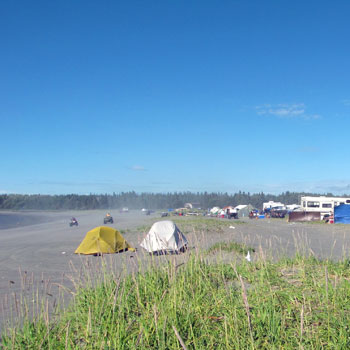
8. South Beach Dipnet Area. Dipnetters are allowed to use this area for dipnetting.
10. Beach Access Road. When you come off the end of Cohoe Beach Access Road, take a right-turn and drive along the beach to get to the dipnetting area. Driving on the dunes, or on beach grass areas is prohibited. 4-wheel-drive is necessary in order to drive on the soft beach. Getting a tow truck into this area is very expensive, so don't attempt it unless you are absolutely sure your vehicle can do it! Every year someone gets stuck in this area.
11. South Beach. Driving is permitted on the beach (motor vehicle and ATV), but not inland of the beach road.
12. St. Elias Avenue. Take a right-turn off of Cohoe Loop Road here to access the lower river boat take-out at Kasilof River Lodge (private take-out).
13. Kasilof River Lodge. This is a great place to stay if you're dipnetting the south side. It's close to the dipnetting area, and they have a take-out here as well. It's not a conventional boat launch in that there is no ramp where you can drive a trailer. Instead, there's a barrier and a cable winch that allows you to hook up to your boat and drag it out of the water, onto your trailer. If you're dipnetting out of a boat, you will not be able to launch here. This is a private take-out and a fee is required to use it.
14. Cohoe Loop Road. This is the access road to the south beach dipnetting area.
Note that the exposed conditions at the Kasilof River mouth can make camping on the lower river uncomfortable, with wind-blown dust and sand. If you plan to camp in a tent, bring plenty of long sand spikes and anchor the tent firmly. Use only tents with stout pole systems that are unlikely to bend or break. A low-profile dome-style tent is best, unless you are camping away from the beach. There is plenty of parking for motor homes and campers, but no hookups.
Restrooms
![]() Portable restrooms are located in both beach areas, and your efforts in keeping them clean and functional will allow them to service the toilets regularly. Do your part by not disposing of trash in the toilets!
Portable restrooms are located in both beach areas, and your efforts in keeping them clean and functional will allow them to service the toilets regularly. Do your part by not disposing of trash in the toilets!
Caring for Your Catch
The Kasilof River is as rustic as it gets, when it comes to amenities. This includes clean water for rinsing your fillets, and local processors for freezing your catch. If you plan to be in the area several days, it might pay off to stay in a paid campground that offers a fish-cleaning station with clean water. You don't want to rinse your fillets in the river, because of the high bacterial counts. The closest processors that can vac-pac and freeze your catch are over on the Kenai River. Some dipnetters opt to bring along a trailer with a chest freezer and a generator, so they can keep dipnetting until they're all done for the season.
Refer to our Caring for Your Catch page for more details on this very important part of dipnetting!
Where are the Fish?
When dipnetters aren't catching or cleaning fish, they're sitting on the tailgate of their pickup wondering where the fish are. Any time you get a group of dipnetters together, you will hear several theories of how to predict the arrival of the proverbial and greatly anticipated "Wall of Fish" all dipnetters dream of. Here are a few theories:
- You won't catch anything when the commercial boats are out. Experience has shown that this is simply not true. Commercial fishing boats off the Kenai River are restricted to fishing very specific zones, and the fishery is specifically managed to meet in-river escapement.
- Large numbers of fish will hit the Kenai three days after a large spike in the OTF. This has shown time and again to be inaccurate. Sometimes it works out that way, and other times it does not. You cannot plan your dipnetting trip based upon OTF numbers exclusively.
- Strong south winds will blow reds ashore at the mouth of the Kenai. Say what?
The single best indicator of fish in the river is the sonar count numbers, which are recorded and posted by the Alaska Department of Fish and Game, sometimes on a daily basis, and sometimes several times a day. The Alaska Outdoors Supersite receives a live feed of this data and we've posted it here on the site. Simply click on the icon below, select the river and year, and you'll know the status of the run.
Experienced dipnetters know that even with all the preparation involved in putting a dipnetting trip together, you can't catch fish that aren't there. Dipnetting the Kenai is all about timing. But the salmon in Upper Cook Inlet (UCI) are a shared resource, with commercial, sport, subsistence, personal use and the ecosystem itself all struggling for an allocation. The Alaska Board of Fisheries is tasked with ensuring that all groups are fairly represented.
What is the OTF?
In 1979, a project was launched for the purpose of estimating the total sockeye salmon return, including the timing of the run, in order to prevent over harvest, and to assist in estimating efficient commercial fishing operations. This project, the Offshore Test Fishery (OTF) consisted of chartering a commercial fishing vessel to conduct sample fishing at six established locations across the Inlet, located on a straight line from Anchor Point to the Red River Delta (Group A in the image below). The locations were selected with the belief that these locations would offer the best assessment of the numbers and timing of the sockeye salmon moving up the Inlet. In 2012, a similar project was launched north of the original OTF, with seven stations located on a straight line across the inlet from the general vicinity of the Kenai River mouth to the northern tip of Kalgin Island and on into Redoubt Bay (Group B in the image below). The purpose of the second OTF was to estimate the distribution of sockeye and silver salmon passing through to northern Cook Inlet. Both the southern and the northern OTF are conducted every year, and the findings are used to coordinate the timing and duration of commercial and subsistence openings, primarily for sockeye salmon.

What have we learned from the OTF?
Data collected by the Offshore Test Fishery in Cook Inlet has been used to support or debunk all sorts of theories about the movement patterns, run timings and destination of schools of sockeye in the Inlet. Perhaps one of the most surprising revelations was that "streams" of salmon move back and forth across the Inlet, seemingly at random. Fish caught on the east side of the Inlet are not necessarily bound for the Kenai River, and fish caught on the west side are not necessarily bound for rivers on the west side of the Inlet. So using spikes in the OTF numbers to predict when fish will hit the Kenai or Kasilof rivers can be very misleading.
Celebrate Diversity! Pick up Someone's Trash!
Very few Alaskans were born here, and most of those came from parents or grandparents who moved here from somewhere else. At the same time, we live among people who can trace their ancestry back to a time when Alaska was a very primitive place, devoid of the modern trappings of development. So Alaska is an amazing melting pot of diverse cultures, with vastly diverse perspectives on nature, the environment, and on how we conduct ourselves in the field. Most of the cultures represented in Alaska today have their roots in a strong love for the outdoors, and an intensely personal environmental ethic. Traditional Samoan culture has a very high regard for the environment and man's place in it. Filipino culture embraces a concept they call "pakikisama", or "harmony", in which getting along with others is respected. They also incorporate the principle of "hiya", or "shame". It's a sense of social decency that drives them to comply with public norms of behavior. Japanese culture embraces the notion of living with nature, as opposed to the Western concept of taming nature. Alaska native culture embraces a love for the land and the creatures that live on it, recognizing man's role as a participant in nature. Western culture, though having gone through times when care for the environment took a back seat to industrial progress, has come full-circle to now setting high standards of environmental protection and accountability. Gone are the days when tossing beer cans into the weeds at the old fishing hole, or flipping cigarette butts into the river were accepted practices. Now, we pick up after ourselves and those around us.
As interest in Alaska grows, we are seeing an increase in the numbers of people on our rivers and lakes. Some of these people come from places where strong environmental ethics were not in place, and they are bringing that here. We are seeing an increase in trash left behind by people who should know better. A bag full of trash, left lying where a trash can used to be, will attract other people to leave their trash in that place as well. Let's break that cycle, by hauling out our own trash.
Regardless of your cultural or social background, we are all Alaskans, and we share a strong environmental perspective. We don't want our home to become like some of the places we came from. The Alaskan environmental ethic drives us to not only haul out our own trash, but to bring along a couple of extra bags to pick up after other people as well. We teach our children to do the same, because this is our cultural norm. Many of the dipnetting sites in Alaska have no trash facilities, and garbage left behind by some becomes a burden others must clean up. Let's take the initiative to show our love for this amazing place by cleaning up after ourselves, and by leaving no trace of our campsites.
Need More Information About Alaska Dipnetting?
We've got you covered! Check out the Dipnetting Menu on the left side of this page, or click one of the links below for more information.
Alaska Salmon Run Charts | Dipnetting Intro | Dipnetting Gear | Dipnetting Techniques | Caring for Your Catch
Dipnetting Locations
Check out the following links to the various dipnetting locations in Alaska.
Copper River | Kasilof River | Kenai River | Fish Creek | Susitna River | Twentymile River



